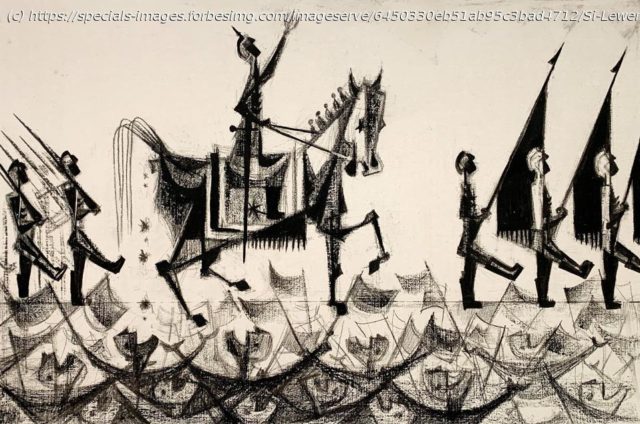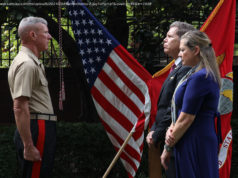Where in Si Lewen’s drawings of the never-ending cycle of war do you see America circa 2023?
Where in Si Lewen’s drawings of the never-ending cycle of war do you see America circa 2023?
The seductive glory? Soldier enlistment? Community deprivation? Destruction? Death? Heartbreak?
Lewen (1918-2016), a Polish-born American artist, understood war intimately. He was a witness to its run-up. Armistice parades following World War I, the rise of Nazism.
A Polish Jewish refugee, Lewen grew up in Germany observing the political and cultural upheaval happening around him at street level. In 1933, when Hitler came to power, he fled to France with his brother and later immigrated to the United States.
After coming to America, he participated in war, enlisting in the U.S. Army at 24 and joining an elite unit of German-speaking special forces called “The Ritchie Boys.” He saw action in Normandy and visited the Buchenwald concentration camp shortly after its liberation in 1945.
Back in the States, more parades again. More military spending. The arms race. Korea. Vietnam. The draft. Global devastation. Death. Central America. Nuclear weapons stockpiling. Iraq. Parades. Afghanistan. Iraq. Parades. More military spending. More obliteration. More death. Endless war.
The Parade begins with images of children and families making their way towards a celebration. Pomp and circumstance a tried-and-true allurement to the supposed glories of war.
After watching a military parade, children wearing paper hats pretend to fight one another. Start ‘em early. All too soon, they are given deadly weapons, and what once seemed like lighthearted fun morphs into a nightmare.
What follows are harrowing, frightening, shocking, angular, frenzied, serrated images. Columns of soldiers. Officers barking orders. The snapping dogs of war. Blood spatters. Arms of the innocent outstretched seeking mercy. Rats. Barbed wire. Coffins.
The series unfolds cinematically, sequentially connecting one image to another to create a powerfully moving work of art.
Without a single written word, The Parade, captures war the way only a participant could have. A people’s history of war and its grisly carnage, not a government censored, corporate sponsored version appropriate for textbooks full of brightly colored uniforms and arrows on a map.
Home
United States
USA — Art Si Lewen’s Terrifying Cycle Of War At Menil Drawing Institute In Houston






